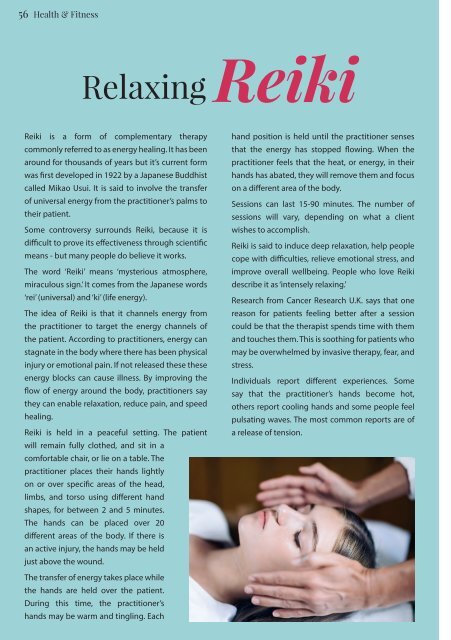Local Life - Wigan - April 2019
Wigan's FREE local lifestyle magazine.
Wigan's FREE local lifestyle magazine.
Create successful ePaper yourself
Turn your PDF publications into a flip-book with our unique Google optimized e-Paper software.
56 Health & Fitness<br />
Relaxing Reiki<br />
Reiki is a form of complementary therapy<br />
commonly referred to as energy healing. It has been<br />
around for thousands of years but it’s current form<br />
was first developed in 1922 by a Japanese Buddhist<br />
called Mikao Usui. It is said to involve the transfer<br />
of universal energy from the practitioner’s palms to<br />
their patient.<br />
Some controversy surrounds Reiki, because it is<br />
difficult to prove its effectiveness through scientific<br />
means - but many people do believe it works.<br />
The word ‘Reiki’ means ‘mysterious atmosphere,<br />
miraculous sign.’ It comes from the Japanese words<br />
‘rei’ (universal) and ‘ki’ (life energy).<br />
The idea of Reiki is that it channels energy from<br />
the practitioner to target the energy channels of<br />
the patient. According to practitioners, energy can<br />
stagnate in the body where there has been physical<br />
injury or emotional pain. If not released these these<br />
energy blocks can cause illness. By improving the<br />
flow of energy around the body, practitioners say<br />
they can enable relaxation, reduce pain, and speed<br />
healing.<br />
Reiki is held in a peaceful setting. The patient<br />
will remain fully clothed, and sit in a<br />
comfortable chair, or lie on a table. The<br />
practitioner places their hands lightly<br />
on or over specific areas of the head,<br />
limbs, and torso using different hand<br />
shapes, for between 2 and 5 minutes.<br />
The hands can be placed over 20<br />
different areas of the body. If there is<br />
an active injury, the hands may be held<br />
just above the wound.<br />
hand position is held until the practitioner senses<br />
that the energy has stopped flowing. When the<br />
practitioner feels that the heat, or energy, in their<br />
hands has abated, they will remove them and focus<br />
on a different area of the body.<br />
Sessions can last 15-90 minutes. The number of<br />
sessions will vary, depending on what a client<br />
wishes to accomplish.<br />
Reiki is said to induce deep relaxation, help people<br />
cope with difficulties, relieve emotional stress, and<br />
improve overall wellbeing. People who love Reiki<br />
describe it as ‘intensely relaxing.’<br />
Research from Cancer Research U.K. says that one<br />
reason for patients feeling better after a session<br />
could be that the therapist spends time with them<br />
and touches them. This is soothing for patients who<br />
may be overwhelmed by invasive therapy, fear, and<br />
stress.<br />
Individuals report different experiences. Some<br />
say that the practitioner’s hands become hot,<br />
others report cooling hands and some people feel<br />
pulsating waves. The most common reports are of<br />
a release of tension.<br />
The transfer of energy takes place while<br />
the hands are held over the patient.<br />
During this time, the practitioner’s<br />
hands may be warm and tingling. Each


















